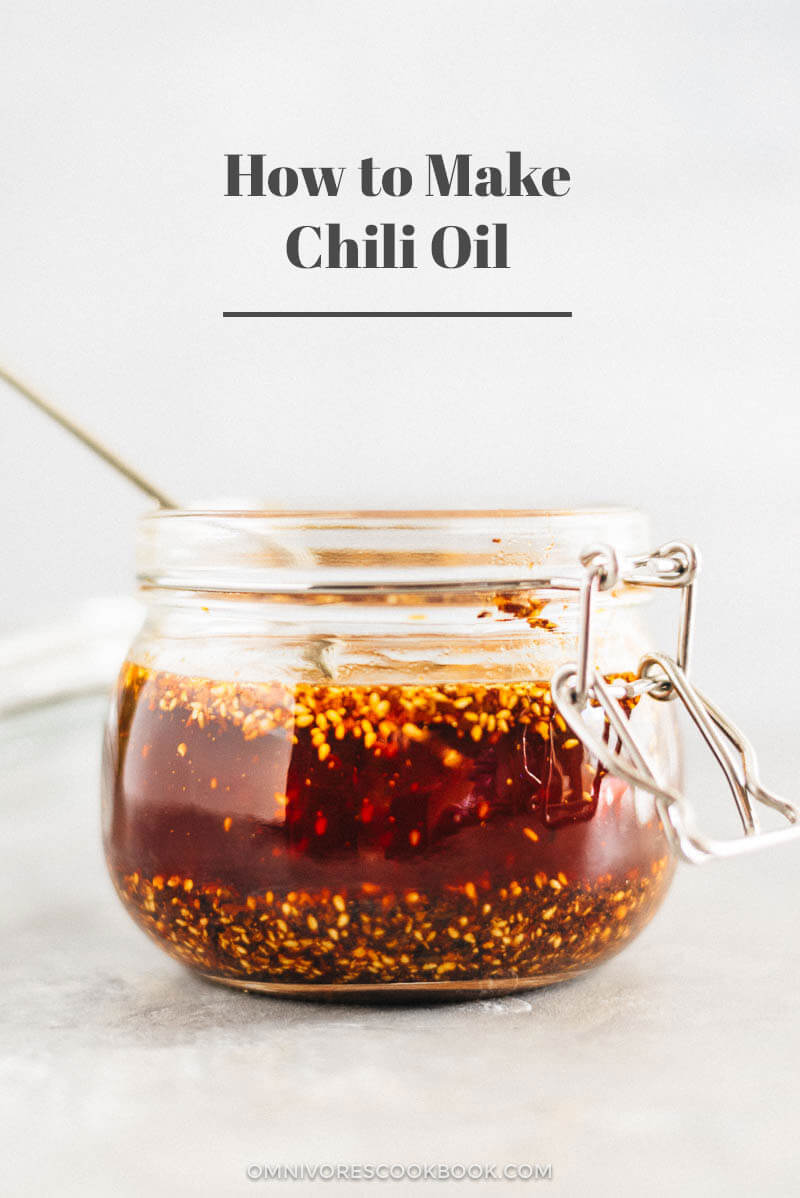
Chili oil is such an important staple for Chinese families, equal to soy sauce and vinegar. For many Chinese people chili oil is as important as ketchup is to American people. It always shows up on tables of small diners, no matter whether it’s a dumplings or noodle place. Once you’re hooked, you’ll want to pour it on everything.
Whenever I’m talking about chili oil, I always refer to homemade chili oil. It tastes ten times better than the store bought product, lasts just as long if you store it in the fridge, and does not contain additives or MSG. There is this fresh aromatic nuttiness that bottled chili oil never delivers.
Plus, when you use chili oil like a Chinese person, you gotta mix in the chili flakes as well. The chili flakes are well toasted when you cook the chili oil, so they taste less spicy but quite smoky with a crispy texture. When mixing with noodles, these tiny umami bits coat the ingredients evenly and each bite releases waves of piquant zing to your taste buds. It’s as exciting as throwing a handful of Pop Rocks in your mouth!
When I cook Vegetable Chow Mein, Lanzhou Beef Noodle soup, and hearty Sesame Noodle Salad, I’ll always spoon a few dollops of chili oil mixed with thick chili flakes onto my finished dish. This one small action will elevate your cooking from mundane to heavenly.
Cooking process
The process might look intimidating at first, but you won’t believe how easy it is once you try it. There are three steps involved.
(1) Combine chili flakes with aromatics of your choice in a heatproof bowl.
A ceramic bowl is my go-to choice. If you plan to use a glass jar, make sure it is heatproof. We will be dealing with hot oil in the next step. Using glassware might cause the glass to shatter and can be very dangerous.
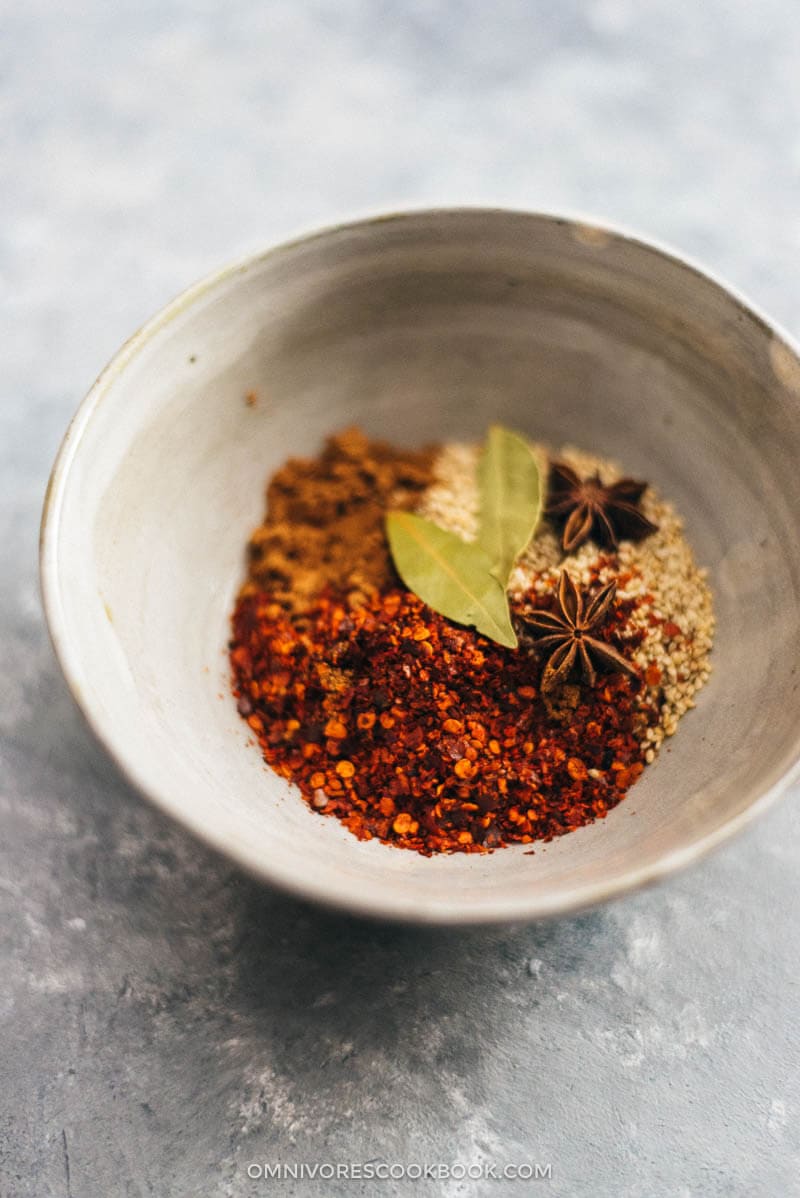
(2) Heat the oil until it reaches 370 degrees F (190 C).
The key to making delicious chili oil is to heat the oil hot enough without overheating it. The hot oil will cook the spices thoroughly and be infused with various flavors. However, if the oil is too hot, it will burn the pepper flakes and sesame seeds, and the resulting chili oil will be bitter in taste.
The best way is to use an instant thermometer to monitor the oil. If you do not have a thermometer, I also introduce a “ginger method” in the recipe below, which is a good indicator of the oil temperature.
Select a small saucepan that has long handle and is good for pouring. Alternatively, you can also use a ladle to transfer the oil.
(3) Pour oil into the bowl with chili flakes.
The oil will bubble fiercely at first and quickly cook the chili flakes. Simply mix everything together with a spoon and let the oil sit until cooled down.
That’s it! Now you have a jar of delicious chili oil to use to create an authentic Chinese flavor.
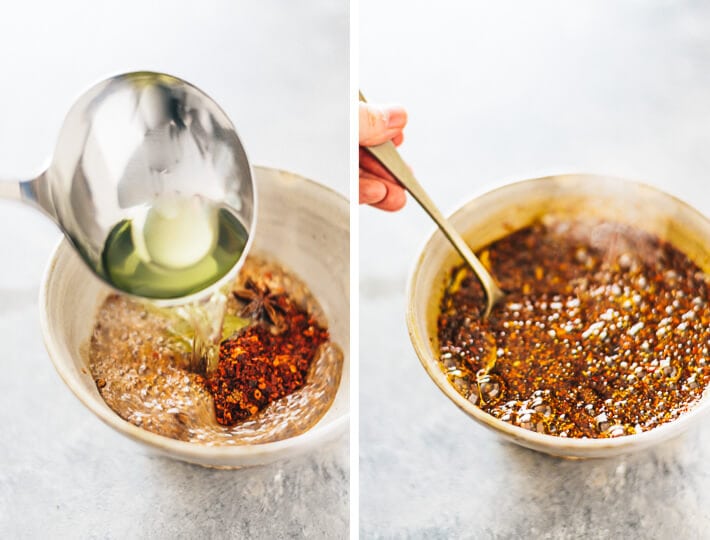
More cooking notes
(1) What types of chili flakes should you use?
The best option is to use fresh chili flakes imported from Sichuan. This type of chili flake is made with premium chili peppers of a vibrant red color. The blend also contains fewer seeds, so your chili oil won’t end up overly spicy.
The next best option is using Korean chili flakes. With these, I found my chili oil doesn’t have the brightest red color, but it doesn’t affect the taste.
(2) How do you make chili flakes?
You can use whole dried chili peppers to make chili flakes too. Lightly toast the peppers in a pan until the pepper turns a bit darker, and grind the peppers into chili flakes. To make sure the oil won’t turn out too spicy, cut open half of the hot peppers with kitchen shears and discard the seeds.
(3) What types of aromatics should you use in the chili oil?
The answer is, you can use many types of aromatics or none at all. The flavor is totally up to personal preference. In China, each region down to each family has their own formula to make their favorite chili oil.
To make the most basic chili oil, you can simply use chili flakes. Some versions use ginger, cinnamon bark, bay leaves, star anise etc.
The recipe below is our family’s formula. We always enjoy adding a few Sichuan peppercorns to add a hint of numbing nuttiness. We also use a pinch of five spice powder to add umami.
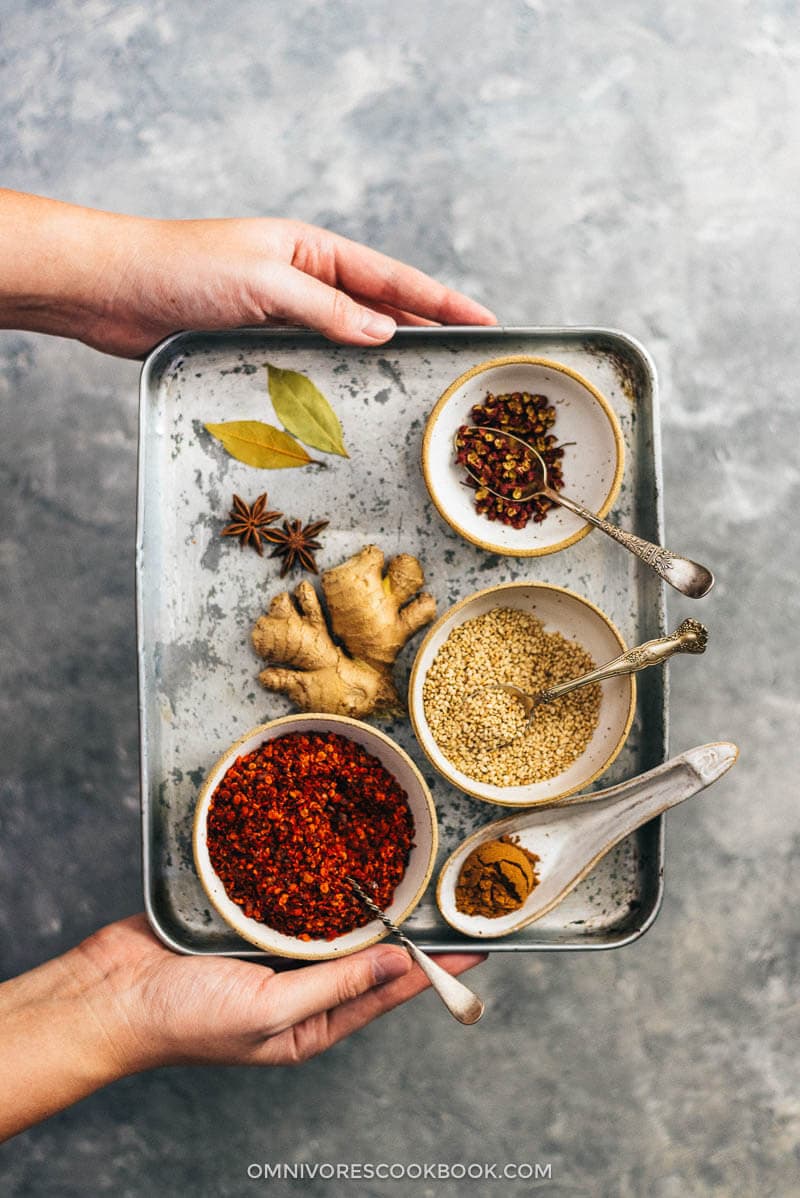
(4) To filter or not to filter the chili flakes?
Once you’ve made the chili oil, you can either filter the oil and discard the chili flakes, or you can leave them in. This habit varies a lot in China depending on the region, so I’d say both methods are authentic and correct.
As a northerner, I grew up having chili oil with tons of chili flakes sitting at the bottom. In fact, in many restaurants you will find the chili oil jar is filled mostly chili flakes and very little oil.
Again, if you choose proper chili flakes (see point #1 above), your chili oil will not be very spicy and it should taste nutty with a balanced umami flavor. The chili flakes should add texture and smokiness to your dish, not spiciness.
How to use chili oil
- Make authentic Sichuan food: Mapo Tofu, Sichuan Spicy Wonton in Red Oil, Sichuan Sliced Beef in Chili Sauce (Fu Qi Fei Pian), Bang Bang Chicken
- Drizzle on soup to make them taste better immediately: Wonton Soup, Instant Pot Chicken Noodle Soup, 15-Minute Curry Ramen with Leftover Ham
- Make a simple cold dish taste irresistible: Real Deal Sesame Noodles, Cucumber Salad
- Use it on congee and oatmeal: 5-Ingredient Savory Oatmeal (Chinese-Style)
- Use it on your roast veggies to add tons of flavor (extremely helpful if you follow a vegetarian or vegan diet)
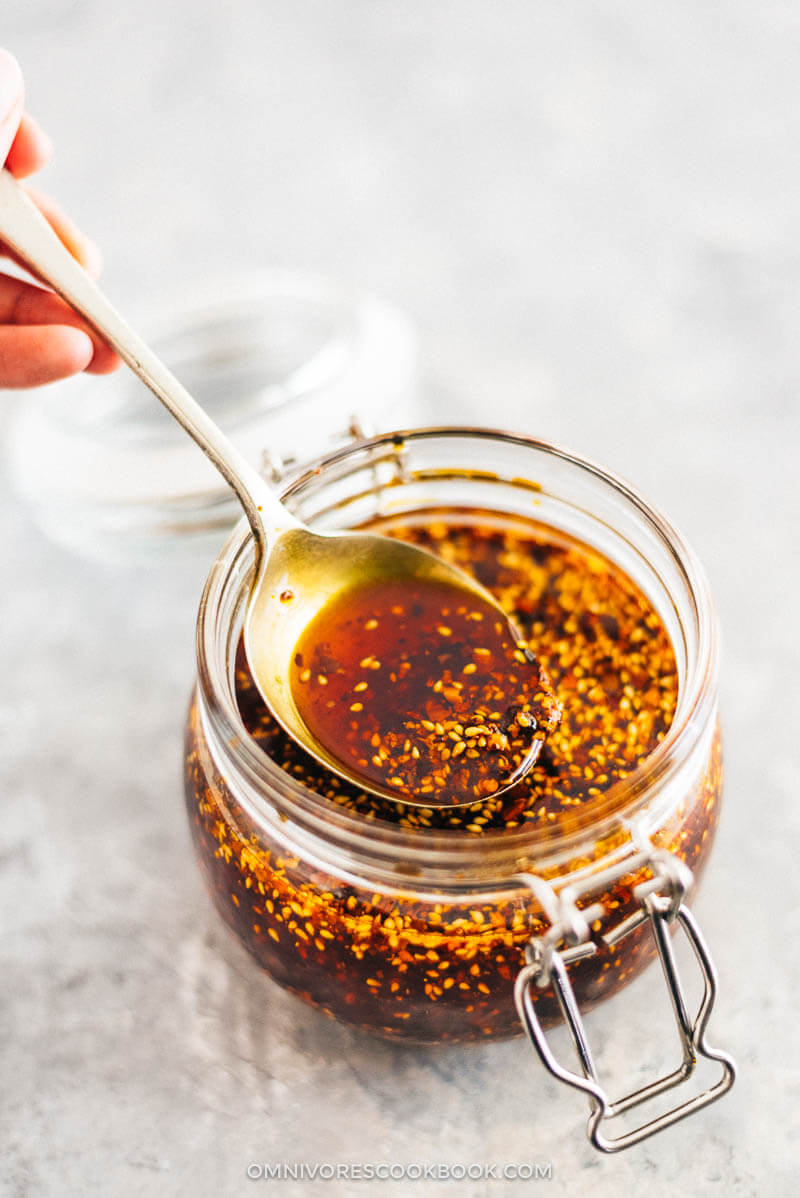
Other homemade Chinese sauces & condiment
- Chinese BBQ Sauce
- Chinese Flavored Sweet Soy Sauce
- Vegetarian Oyster Sauce
- Homemade Black Bean Sauce
If you give this recipe a try, let us know! Leave a comment, rate it (once you’ve tried it), take a picture and tag it @omnivorescookbook on Instagram! I’d love to see what you come up with.
Chinese Cooking Made Easy
Are you new to this website? This free email series is a great place to start. I’ll walk you through a few of my most popular recipes and show you how and why they work. You’ll quickly start to cook better Chinese food in your own kitchen.
Watch video
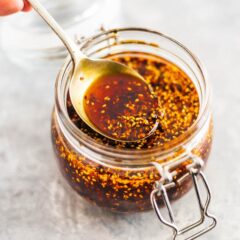
How to Make Chili Oil (辣椒油)
Ingredients
- 4 tablespoons Chinese chili flakes (*footnote 1)
- 2 teaspoons five spice powder
- 3 tablespoons toasted sesame seeds
- 1 teaspoon ground Sichuan peppercorn
- 1 whole star anise (Optional)
- 2 bay leaves
- 1 cup vegetable oil (or grapeseed oil)
- 1 piece thinly sliced ginger (Optional)
Instructions
- Combine chili flakes, five spice powder, sesame seeds, star anise, Sichuan peppercorns, and bay leaves in a heatproof ceramic bowl that can hold at least 2 cups liquid. Place the bowl on a heat resistant coaster.
- Heat oil in a wok (or a skillet) over medium-high heat. Add ginger. When the ginger starts to wither and turns golden brown, immediately turn off the heat. The oil should reach 370 degrees F (190 C) and no higher than 400 F (200 C) if read with an instant thermometer.
- Carefully pour oil or use a ladle to transfer oil into the bowl of mixed spices. The oil will bubble for a few seconds and cook the spices. While the the oil is bubbling, use a metal spoon to stir gently to mix the spices, so they’ll cook thoroughly.
- When the oil cools down a bit, scoop out and discard the star anise and bay leaf.
- The oil is now ready to use! Its flavor will mature if you let it rest for a day, allowing the spices to infuse into the oil.
- The oil can be stored covered at room temperature for two weeks, or up to six months in the fridge in an airtight container.
Notes
Nutrition

Did you make this recipe?
I’d love to hear how it turned out for you! Please take a moment to leave a 5-star rating ⭐️ and share your thoughts in the comments further down the page. It really helps others discover the recipe too.
The recipe was originally published on August 7, 2014, and updated on April 23, 2017.

nicole
hi. How log does it keep?
Maggie
Hi Nicole, the chili oil will last very long time if you store it in a jar in the fridge. One jar lasted half a year in my fridge without any problem. Although just like any other homemade sauce, it tastes the best when it’s fresh and it will last for at least 3 months without any problems.
Salle
I have been making this frequently, thanks to your easy directions and recipe. I’m hooked! I like to use a mix of regular, organic chili flakes (from the grocery spice section) and ones I got at an Asian grocery store, because that way it isn’t too spicy, just smoky and wonderful. My absolute favorite way to use it is as a simple dunking sauce for roasted squash, carrots and sweet potatoes. Just standing over the counter, being amazed at how delicious it is. And even though I’ve transitioned to a “no meat, no dairy, no eggs” lifestyle, I still get to keep my homemade chile oil. Thank you!
Rekha
Hi Maggie,
Thanks for sharing such a wonderful recipe. I don’t know how often you make it at home, but I’ve made it 2x in the last two weeks because it is a hit with my family, and the results are amazing and consistent. Thank you!!!
Salle Huber
I thought I was getting the right kind of chile, but now I see not.
I got two different items…dried prickly ash, and ot mieng. Can I use these for my chili oil? (I made some with regular organic chili peppers from whole foods…like you would put on a pizza…and it was very good and smoky, but not spicy at all.)
Thanks for advice. Love everything you post.
Maggie
Hi Salle, thanks so much for your kind words!
I didn’t see the packages you get, but judging by the names, I think you can use dried pickly ash (aka Sichuan peppers) and ot mieng to make the chili oil. In fact you can use various types of chili peppers to make the oil, which results in different flavors. IF you use the regular chili peppers (smoky but not spicy) again, you can blend in a small portion of cayenne powder or crushed Thai chili peppers (1 to 2 teaspoon per cup of oil) to add spiciness.
I hope your next batch of oil comes out beautifully 🙂
Janie
Under the photograph, you write “(2) Heat the oil until it reaches 275 degrees F (135 C).”
In the recipe you write, “(2) Heat the oil until it reaches 275 degrees F (135 C).”
Which is it?
Thanks
Janie
WHOOPS!!!!
I didn’t notice that my second copy didn’t take before I clicked Post Comment. Sorry about that.
It should read : “In the recipe you write, “The oil should reach 370 degrees F (190 C) and no higher than 400 F (200 C) if read with an instant thermometer.”
Maggie
Hi Janie, sorry about the confusion! It should be 370 degrees F (190 C). I just updated the blog post so now it’s consistent.
Happy cooking and I hope your chili oil turns out delicious 🙂
Janie
Thanks, Maggie!
janie
Chit
I just watched your you tube on chili oil! Wow that simple? Am excited to do it now! By the way Maggie I cooked the chicken fried rice last night! So yummy! My husband enjoyed it too! You are amazing! Recipes are simple tasty and very authentic Chinese flavor! And your pretty Maggie! May you continue to be inspired in the kitchen!
Maggie
There are a few ways to cook chili oil and this is my favorite method, because it is simple and generates great result 🙂
Thanks for leaving a comment and let me know about the fried rice. Glad to hear you guys enjoyed the dish!
Marija
This is completely addictive! The recipe is so simple and straightforward, and the result is just… poetry for the palate. I’ve poured this on everything, from Chinese noodle soups, to roasted potatoes, to salads, cold meats… It really does bring every dish up a notch. Thank you!
CO Lee
that’s the way we are too! It goes on everything. And I just made a new batch …
Martin
Hi Maggie wich temperature should i pour the oil on the chilies when it reaches 135*celcius or 190*?
Maggie
Hi Martin, you should wait until the oil reaches 190C. Although sometimes I don’t really measure the temperature, because the air above the pan can get really hot.
What you can do is to pour a small amount into the oil and see if it sizzle. That can be an easier judgement.
Martin
Hi Maggie again i’m sorry to ask once again about the same topic here. I forgot to ask aswell if i have to toast the chilies before doing this to make it bring more flavour to the oil or should i skip this? this is my final question i would be very thankful if you could reply once more. Thanks again!
Maggie
Hi Martin, no worries and please feel free to ask a question anytime!
No you don’t need to toast the chillies flakes because the hot oil will toast it and bring out a lot of flavor.
On the other hand, if you’re making the oil from whole chili pepper, toast the whole peppers can be helpful before you grind them.
Happy cooking and let me know how the chili oil turns out! 🙂
Jeff Stern
Love your site and your recipes. This is a great primer on making chile oil. I know how to make herb infused oils but this is a new take for me. Thanks!
Milena | Craft Beering
I am glad you brought this post back into the spotlight. Pinning to try and make our own chili sauce soon, we usually purchase it, this looks fun and I can only imagine how much better it tastes.
Maggie
Thanks so much for sharing Milena! Yes you should definitely make it once at home. It is so easy and the result tastes way better than the bottled chili oil!
Christine Morgan
I just want to take a moment to thank you so much for the recipe of chili oil. This is my new a chapter of my life using your recipes, the best part of all is that you use pictures of the ingredients I want to go to the store I can at least open the phone and show them a picture of what I need and that’s the most important sometimes translation is very hard for me but I just want to thank you!!!! Looking forward to many recipes of yours!
Maggie
Hi Christine, thanks so much for the kind words and I’m glad to hear my ingredient pictures are helpful! I’ll make sure to take more ingredients photos and add them in my future posts as well 🙂 Yes navigating an Asian market can be frustrating sometimes, even when you understand the language. Last time it took me 15 minutes to locate a small pack of powder for tofu making!
Anyhow, happy cooking and hope you have a great week ahead 🙂
Paula LaBine
Hi Maggie! I’m currently visiting Xian and loved Biang Biang noodles so much, I wanted to see a recipe for them and that’s how I found you. Great site and I can’t wait to try your recipes when I get back to the US. We were previously in Chengdu and when we ate dumplings, they always had this red chili condiment on the table to eat with them. It had some floating oil on top, but was more of a chili paste. Is this recipe similar that that, with more oil added?
CJ
I stumbled on your blog. You make cooking so easy and your short cuts are great. Thanks.
Maggie
You’re the most welcome CJ! And glad to hear you found my blog helpful! Happy cooking and have a great week ahead 🙂
dylan
My seasame seeds don’t see to float like yours! And my chili flakes don’t sink! Haha, did I do something wrong?
I can’t believe how awesome the spicy/nuttiness is! Amazing!
Maggie
I think the chili flakes will sink if you set them aside for a bit longer? The sesame seeds? I have no idea! In fact I’d like them to sink, because they sometimes get in the way lol I think it’s fine as long as it doesn’t affect the taste.
Glad to hear you enjoyed the chili oil 🙂 Use it on noodle salad and it will make the dish awesome.
Menolly
Did you toast your seeds? I think I read somewhere that if you toasted your seeds they would be more likely to float. Il try to find the article again.
Nataline
Thank you so much for this recipe! I tried it side by side with the recipe from Woks of Life and prefer this one, largely because of the sesame seeds which add a nice crunch. The Woks of Life version was very similar, but because it has more Sichuan peppercorn, ended up a bit warmer. I am so addicted to the nutty smoky taste of this chili oil.
Maggie
Hi Nataline, I’m glad to hear you like the recipe! Adding sesame seeds into the chili oil does boost its flavor a lot, so I personally prefer this way too. Thanks for taking time and leaving a comment to let me know 🙂 Have a great day!
Deborah
Trying to sign up for newsletter and e-cookbook but it doesn’t go through. What’s up with that?
Maggie
Hi Deborah, many many thanks for letting me know about this problem. I just realized my newsletter system released an upgrade and I didn’t install it properly. Now the newsletter signup form works properly and you should able to sign up. Could you please try it again? Thank you for your time, and I really appreciate your help 🙂
Thomas
This has become a staple condiment of mine and I make it about once a month. Nothing compares to the nutty spiciness, and I just can’t get enough.
To get the hot oil just right, I use either vegetable or peanut oil, heat it to 430-440F, and pull it off the burner right as I start to smell a hint of smoke. I suppose other oils will work, but any oil used needs a smoke point above 430F, in order to toast the spices and extract flavor properly without burning.
I found that the ginger test isn’t quite accurate. My ginger slices turned into crispy (and delicious) ginger chips around 400F (I removed them and ate them once they were totally toasted). This may have to do with the fact that an electric stove (which I was using) heats more slowly. The best way to judge the temperature of the oil is to monitor it very closely – with a thermometer or by paying close attention to the faintest hint of smoking oil, or both.
Sophie
I like how each family seems to make their own version of chile oil 🙂 I add scallions to mine (but fish them out before sealing the jar in the fridge). I love it! I just ran out actually because whenever I’m frying day-old rice or noodles I use lots….. it’s my favorite! Thank you for sharing your version (and good tip about not eating any whole peppercorns :):)
Maggie
Adding scallion to the chili oil sounds so tasty! I never tried to add chili oil into fried rice, but it sounds great! Thanks for sharing the ideas and I cannot wait to try them out! 🙂
Villainesse
As a music student working on my masters, I shared an apartment with a violinist from Beijing who taught me many such simple recipes. Imagine my horror when I cooked back home and my father tossed the large amount of remaining oil in the garbage! Thanks for the hint on fishing out those lovely green onions for long storage, whose flavor is wonderful in any hot oil.
Nami | Just One Cookbook
Yay for homemade Chili Oil! I’m going to try your recipe next time!
Maggie
I’m so happy to hear there are people who prefer to cook those things at home. Happy cooking and let me know how it goes! 🙂
Sherry DeJanes
This is the best chili oil I’ve ever had!!!
Crystal | Apples & Sparkle
Thank you so much for sharing this Maggie! I really enjoy making my own condiments when I can, I can just imagine how superior this is to the store bought kind. : )
Maggie
Thanks Crystal! I’m totally agree with you, those homemade condiments have much better flavor. It takes no time after you get used to the cooking process. 🙂
Menolly
How does it only make 1 cup? There a cup of oil, plus almost 1/2 cup between the chilies, the sesame seeds and the spices? I’m trying to order a jar to store it, and I’m really confused about the total volume of the recipe.
Susi
Thank you Maggie. I and My hubby give 2 thumbs up for this chili oil. So fragrant.